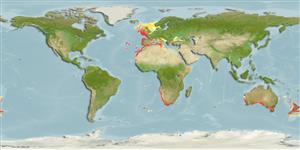Classification / Names
Common names from other countries
Main reference
Size / Weight / Age
Max length : 210 cm TL male/unsexed; (Ref. 36731); common length : 117 cm SL male/unsexed; (Ref. 6181); max. published weight: 8.0 kg (Ref. 6181)
Length at first maturity
Lm ?, range 92 - ? cm
Environment
Marine; benthopelagic; oceanodromous (Ref. 51243); depth range 42 - 620 m (Ref. 56504), usually 100 - 300 m (Ref. 6181)
Climate / Range
Deep-water, preferred 24°C (Ref. 107945); 64°N - 49°S, 29°W - 176°W (Ref. 6181)
Distribution
Eastern Atlantic: France and western Mediterranean to Senegal, including Azores, Madeira, the Canary Islands and offshore seamounts; Cape Fria, Namibia to Agulhas Bank, South Africa including northern Walvis Ridge. Southern Indian Ocean: seamounts 30 to 35°S. Southwest Pacific: Australia (New South Wales to southern West Australia) and New Zealand. Southeast Pacific: Peru. A doubtful record from Cape San Lucas, Mexico.
Countries | FAO areas | Ecosystems | Occurrences | Introductions
Short description
IUCN Red List Status (Ref. 115185)
Threat to humans
Harmless
Human uses
Fisheries: highly commercial; gamefish: yes
Tools
Special reports
Download XML
Internet sources
Estimates of some properties based on models
Phylogenetic diversity index
PD50 = 0.5156 many relatives (e.g. carps) 0.5 - 2.0 few relatives (e.g. lungfishes)
Trophic Level
3.8 ±0.3 se; Based on diet studies.
Resilience
Medium, minimum population doubling time 1.4 - 4.4 years (K=0.06-0.3; tmax=7)
Vulnerability
Moderate to high vulnerability (53 of 100)
Price category
